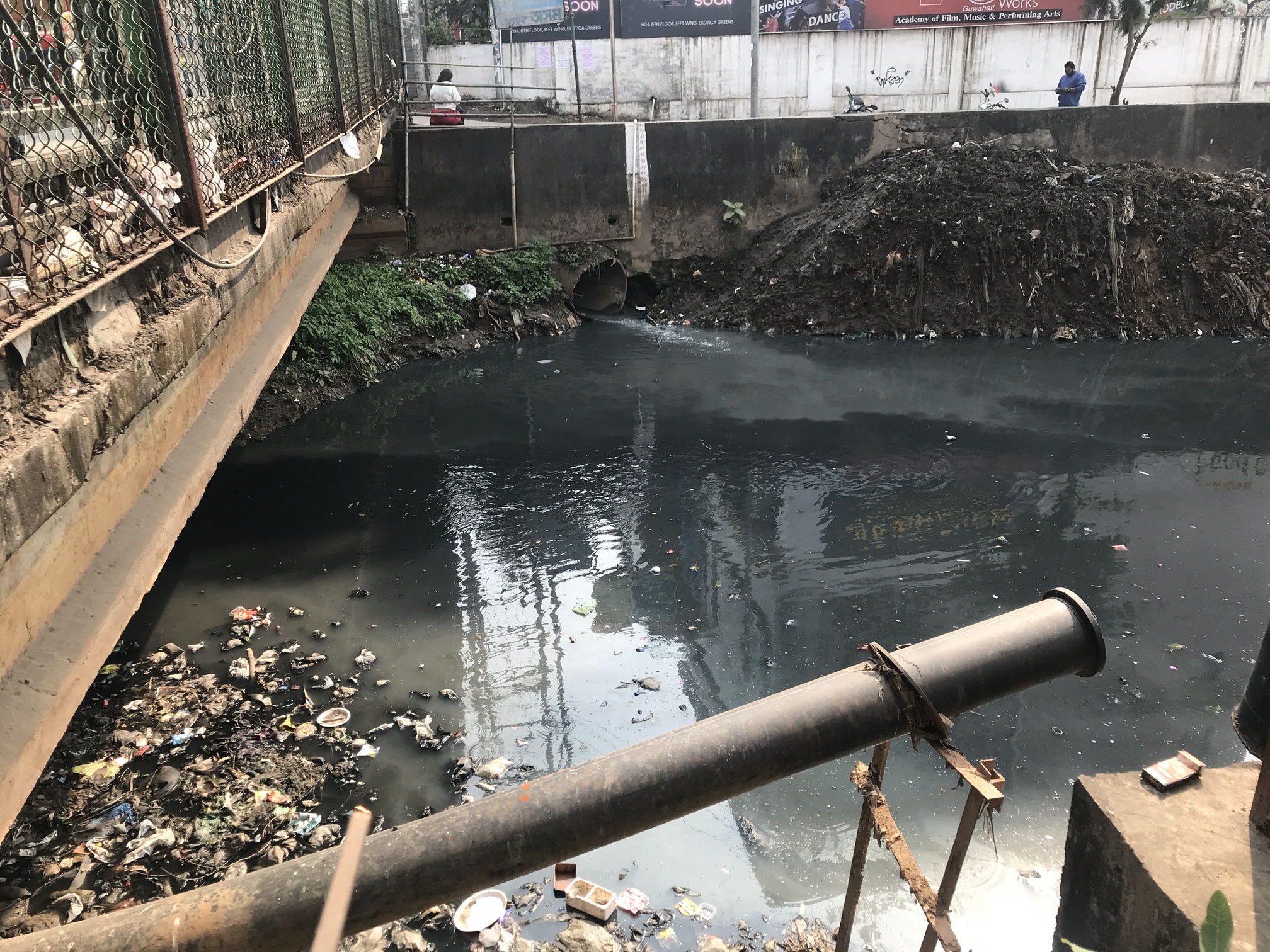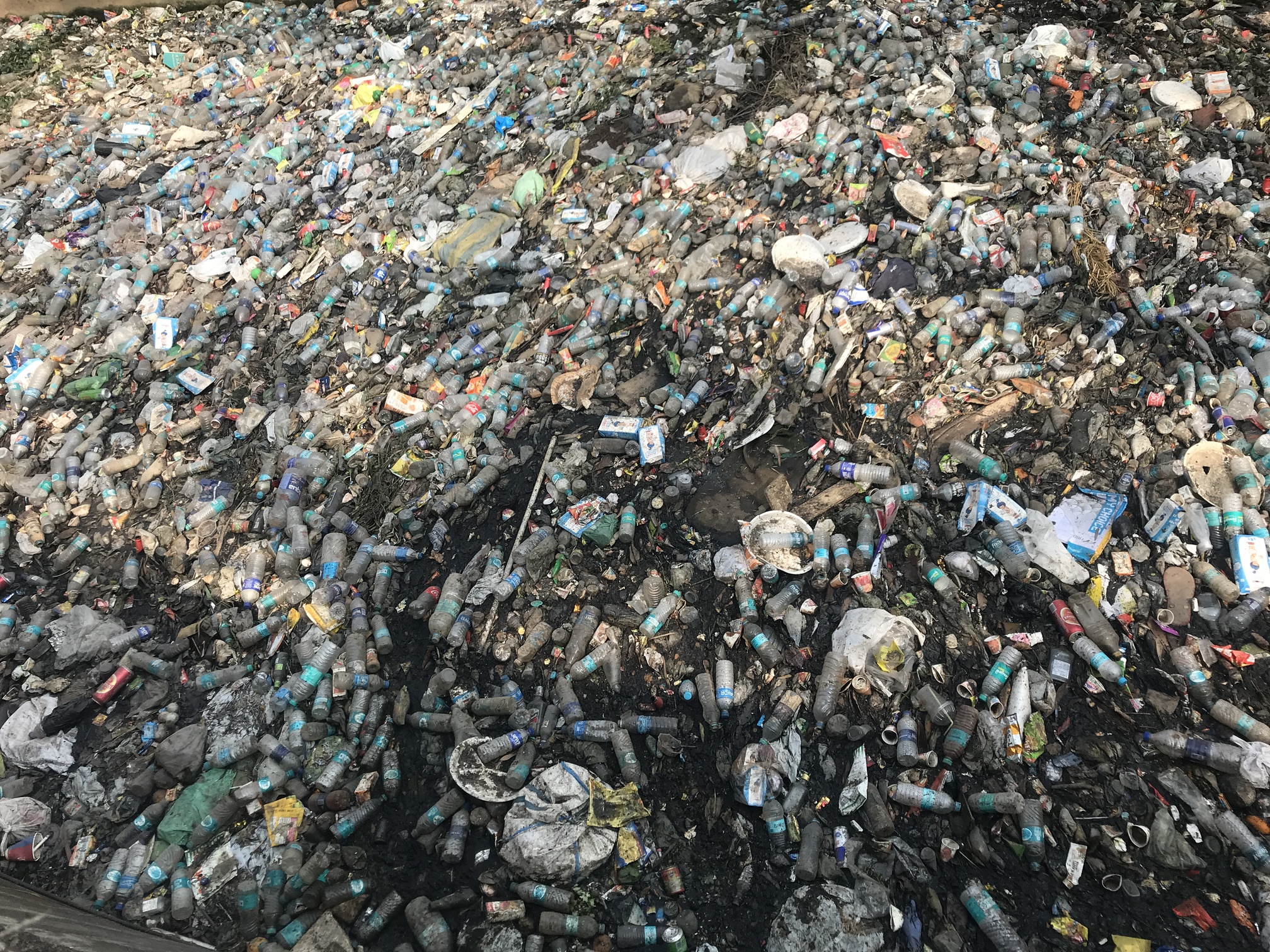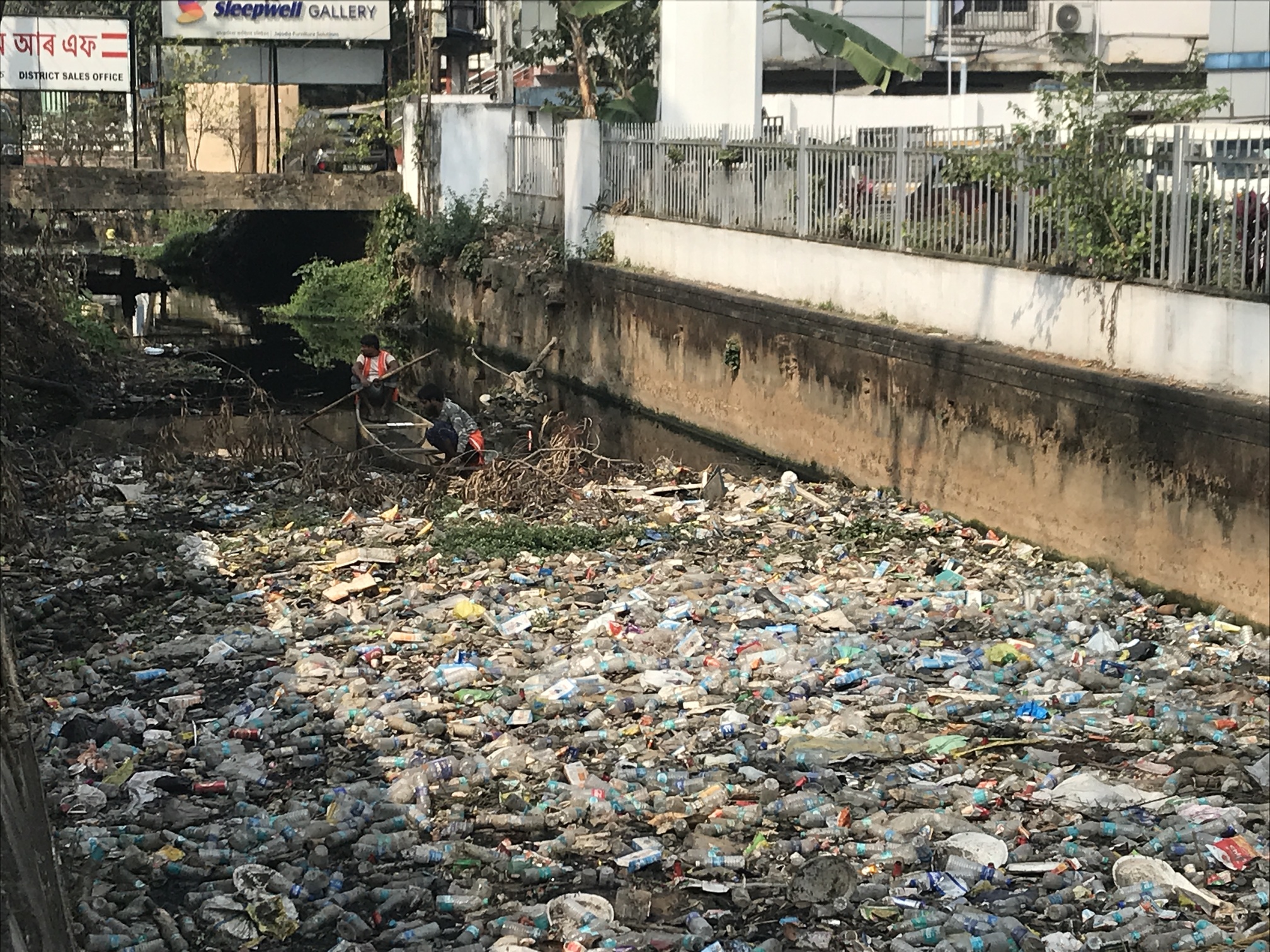Neither sewerage, nor sewage treatment plant, the Bharalu river is a sewage channel
The Bahini-Bharalu, Guwahati's main river, carries a large chunk of untreated sewage and empties it into the Brahmaputra river. Polluted sewage also flows into a bird sanctuary. The sewage generation is expected to go up ...

Guwahati, Assam
“In the 1970s, when I was a child, our house was next to the Bharalu river. That time the river water was clean and we used to play in it and catch fish. During festivals, people from the neighbouring villages used to come to catch fish, too,” reminisced Kalyan Das, professor and director-in-charge of Guwahati-based OKD Institute of Social Change and Development, an autonomous research institute of ICSSR (Indian Council of Social Science Research) and Government of Assam.
Gradually, the river water quality started to deteriorate and post 1985, Bharalu river turned into a drain, which now only carries polluted water and untreated sewage of the city, he added.
Welcome to Guwahati, Assam’s largest city located in Kamrup Metropolitan district, whose urban river Bharalu is nothing more than a sewage channel.
With an estimated population of about 1.7 million, Guwahati, one of the Smart Cities under the Indian government’s Smart Cities Mission, neither has sewerage (network of pipelines to carry sewage), nor any municipal sewage treatment plant (STP) to treat the wastewater. Practically, the entire city depends on underground septic tanks to manage its sewage, which is a threat to the groundwater quality.
Groundwater contamination is a concern because at present, only 30 per cent of the city population is covered by piped water supply system at a consumption level of around 70 litres per capita per day. Rest of the city population depends on groundwater by means of individual bore well or supply by private operators through tankers.
“Guwahati is selected as a Smart City and there are plans to set up municipal sewage treatment plants. But, at present, there is no such facility in the city,” Biswajit Pegu, deputy commissioner of Kamrup Metropolitan district told Gaon Connection. “Bahini-Bharalu river carries the main load of untreated sewage of the city. Some of the untreated wastewater also enters Deepor Beel,” he added.
“Not just Guwahati, there is no municipal sewage treatment plant anywhere in Assam,” informed Y Suryanarayana, chairperson of Assam Pollution Control Board. “Residential and commercial complexes have their own underground septic tanks whose regular cleaning is the responsibility of Guwahati Municipal Corporation. There is no centralised sewage collection and treatment system in the city,” he added.
Experts claim there are no private players involved in cesspool operation and the urban local body does not have the adequate capacity in terms of cesspool vehicles to meet the city’s demand for clearance of these septic tanks.
Predictably, the city’s main river, Bahini-Bharulu, which flows through the metropolis and is a small tributary of the Brahmaputra, receives a large chunk of untreated wastewater and has turned into a putrefying sewage canal. At several locations, the sewage-filled river is covered with a thick layer of plastics and other wastes.
“We don’t yet have a municipal sewage treatment plant. And, it is unfortunate that Guwahati is releasing most of its stormwater, which carries sewage and pollutants, not only into the Brahmaputra through Bahini-Bharalu river, but also into Deepor Beel, an important wetland and a Ramsar site,” said Partha Jyoti Das, head of Water, Climate and Hazard division of Aaranyak, a Guwahati-based scientific and industrial research organisation.
“Untreated sewage is a big source of concern for water quality of surface water bodies and urban wetlands. In the long term, it is a threat to the quality of city’s groundwater,” he added.

River or drain?
Bahini-Bharalu river is a small tributary of the Brahmaputra, which flows down from the foothills of Khasi hills in Meghalaya. This urban river passes through heavily congested areas of the city with shopping malls, automobile showrooms, housing colonies, hotels, etc along its journey. It is a natural drainage channel of Guwahati, which has turned into a stinking drain.
“Bahini and Bharalu is the same river. The initial 13 kilometre [approximate] stretch of the river is known as Bahini, which gets named Bharalu after it passes the Assam State Botanical Zoo area. The stretch of Bharalu river is 6.2 kilometres and it eventually meets the Brahmaputra river at Bharalumukh [mouth of Bharalu],” informed an official of the Assam Pollution Control Board (see map: The Bharalu river system).
Meanwhile, another stretch of Bharalu river — Basistha river — branches out towards the Borsola beel (beel in Assamese means a lake), from where it flows further down and meets Deepor Beel located at the outskirts of the Guwahati.
Deepor Beel has international significance. Not only is it the largest wetland in the state, this freshwater lake sustains various aquatic species, including fishes, and migratory birds. In November 2002, it was declared a protected Ramsar site (under the Ramsar Convention on Wetlands, 1971) and is also an important bird sanctuary.

Source: http://www.pcbassam.org/rlcc/BHARALU/Bhalaru%20City%20Sanitation%20Plan_Draft%20Final.pdf
A December 2013 report of the Assam Pollution Control Board reads: “The Bharalu carries a large portion of the city’s municipal and other wastes and also serves as the natural drainage for storm water runoff. The waste water from households, commercial/business establishments, and small to medium industries within the city flows directly into the Bharalu River through the system of mutually interconnected drains. The degradation caused by domestic and commercial wastes poses a serious threat especially for the inhabitants of Guwahati and finally the downstream receptor, the Brahmaputra.”
The website of Assam Urban Infrastructure Investment Program reads: “In Guwahati, the household wastewater is directly discharged to the storm water drains, which ultimately discharges into the Brahmaputra River, causing river water pollution and unsanitary condition of the area.”
“In all, there are 330 drains in Guwahati city that carry stormwater, often mixed with untreated sewage, and empty it into the local beels or Bahini-Bharalu river. Eventually, it all flows into the Brahmaputra. We regularly clean and desilt these 330 drains,” Debeswar Malakar, commissioner of Guwahati Municipal Corporation told Gaon Connection.
However, there is no official data on the total amount of sewage generated in Guwahati. “We do not have any official estimate of the total amount of sewage generated in the city. There is no sewerage or municipal sewage treatment plant in the city,” he added.
Sector experts point out the present generation of sewage in the city is about 70 million litres daily (mld), which will eventually increase with installation of the new water supply systems in the Guwahati Metropolitan Area. The sewage generation is expected to increase to around 280 mld by 2025.

Bharalu, one of the most polluted rivers in India
The Central Pollution Control Board (CPCB), which monitors and identifies polluted river stretches in the country, has identified Bharalu river of Guwahati as one of the most polluted rivers in the country.
Based on the water quality testing, the central monitoring agency rates polluted rivers on a scale of one to five with ‘priority 1’ category including rivers with biological oxygen demand (BOD) concentration of 30 milligram per litre (mg/l) or above. It must be noted that a BOD of 3 mg/l is desirable.
The CPCB has included Bharalu river in ‘priority 1’ category of polluted river stretches, as it recorded BOD level of 52 mg/l in the river and the main source of pollution was identified as Guwahati’s sewage.
Taking cognisance of the 45 critically polluted stretches across the country (as compiled by the CPCB), including Bharalu river of Guwahati, in September 2018, the National Green Tribunal (NGT), ordered preparation of action plans “to restore the polluted river stretches to the prescribed standards”. Among other things, the action plans need to include the source control of domestic and industrial pollution, channelisation and disposal of treated domestic sewage, river basin management and periodic checking of groundwater quality, etc.
Action plan to clean and rejuvenate Bharalu river is ready. And, it promises a pollution-free Bharalu within a year by March 31, 2021.
“As per our estimate, 39 drains empty into Bahini-Bharalu river, of which 17 are major drains. In accordance with the NGT order, we have prepared an action plan, which was forwarded to the CPCB and has been approved,” informed the official of Assam Pollution Control Board.
According to him, the plan includes setting up three decentralised sewage treatment plants along Bharalu river with a combined capacity to treat 75 kilo litres of sewage daily. It also directs regular dredging and cleaning of beels.
“Our action plan proposes three decentralised sewage treatment plants for the drains emptying into Bharalu. This is in accordance with the NGT order. We haven’t looked at the total sewage generated in Guwahati city,” said Suryanarayana. He informed that action plans have been prepared for all the 44 polluted rivers identified in Assam by the CPCB.
However, experts raise serious doubts over rejuvenating the highly polluted Bharalu river within a year. In the past, several efforts, including preparation of detailed project reports (DPRs), have been made by various agencies, but the river has remained dirty as ever.
DPRs notwithstanding, Bharalu still polluted
Almost a decade back, the Union Ministry of Environment, Forest and Climate Change, through the Assam Pollution Control Board, engaged Indian Institute of Technology Guwahati (IITG) to prepare detailed project reports to revive Bharalu and Kolong rivers in Assam. The institute spent two years researching on Bharalu and Kolong rivers and prepared a detailed plan. But, the same wasn’t accepted by the ministry terming it ‘incomplete‘.
Among other things, this report of IIT Guwahati recommended physically securing Bharalu river along with a buffer zone on both banks, restoration of flow of Bahini, stopping rock quarries and hill cuttings in hill catchment, installing decentralised wastewater treatment systems, etc.
Afterwards, in the year 2013, for the preparation of DPR for conservation of Bharalu and Kolong river, a joint venture between the US-based The Louis Berger Group and New Delhi-based DHI (India) Water & Environment Pvt Ltd was entrusted. In December 2013, these agencies prepared detailed project report for conservation of Bharalu and Kolong under City Sanitation Plan initiative and held public consultations.
Local groups, including the city-based non-profit The Society for Socio-Economic-Development in the Region (SSEDR), protested against the manner in which these consultations were held. They also raised questions over the project reports.
While the investigations are on, as per the directions of the NGT, the Assam Pollution Control Board has prepared yet another action plan to revive Bharalu river within a period of one year.

Projects in the pipeline
The Government of India has approved the Japan International Cooperation Agency (JICA) assisted Rs 1,178.75 crore Guwahati Sewerage Project in zone-I of the city. In February 2015, JICA signed an official development assistance loan agreement with the Indian government for this sewerage project.
The objective of the project is to provide reliable sewerage services by carrying out the construction of sewerage facilities and an extensive network of sewers in South and East Guwahati. The JICA is providing Rs 1001.28 crore funding and the state’s share is Rs 177.47 crore. The total duration of the project is seven years.
The project includes laying of trunk sewer length of 201 kilometre (km), lateral sewer of 501 km and 101,058 house connections. There is proposal to set up 187 mld capacity sewage treatment plant based on activated sludge process.
Already five years of the total seven years project duration are over and little progress has been made.
Will Bharalu river be clean by March 2021?
This story has been published as part of the WaterAid India ‘WASH Matters 2019’ Media Fellowship Program.

